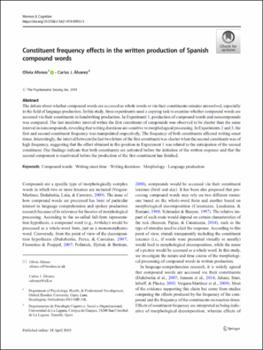Constituent effect in the written production of Spanish compound words
Fecha
2019Resumen
The debate about whether compound words are accessed as whole words or via their constituents remains unresolved, especially
in the field of language production. In this study, three experiments used a copying task to examine whether compound words are
accessed via their constituents in handwriting production. In Experiment 1, production of compound words and noncompounds
was compared. The last interletter interval within the first constituent of compounds was observed to be shorter than the same
interval in noncompounds, revealing that writing durations are sensitive to morphological processing. In Experiments 2 and 3, the
first and second constituent frequency was manipulated respectively. The frequency of both constituents affected writing onset
times. Interestingly, the interval between the last two letters of the first constituent was shorter when the second constituent was of
high frequency, suggesting that the effect obtained in this position in Experiment 1 was related to the anticipation of the second
constituent. Our findings indicate that both constituents are activated before the initiation of the written response and that the
second component is reactivated before the production of the first constituent has finished. The debate about whether compound words are accessed as whole words or via their constituents remains unresolved, especially
in the field of language production. In this study, three experiments used a copying task to examine whether compound words are
accessed via their constituents in handwriting production. In Experiment 1, production of compound words and noncompounds
was compared. The last interletter interval within the first constituent of compounds was observed to be shorter than the same
interval in noncompounds, revealing that writing durations are sensitive to morphological processing. In Experiments 2 and 3, the
first and second constituent frequency was manipulated respectively. The frequency of both constituents affected writing onset
times. Interestingly, the interval between the last two letters of the first constituent was shorter when the second constituent was of
high frequency, suggesting that the effect obtained in this position in Experiment 1 was related to the anticipation of the second
constituent. Our findings indicate that both constituents are activated before the initiation of the written response and that the
second component is reactivated before the production of the first constituent has finished.






